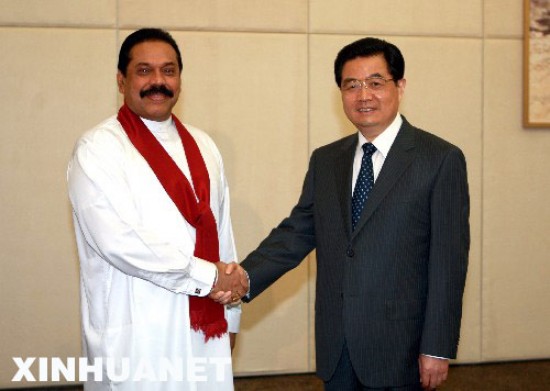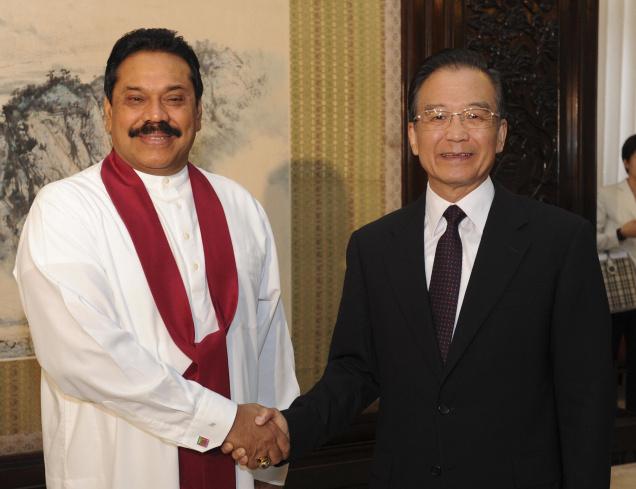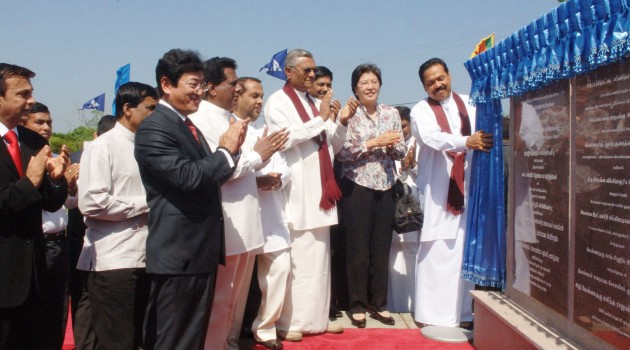Strategic takeover : Are we misreading Chinese largesse in Sri Lanka?
Beijing has considerable leverage in post conflict Sri Lanka. Chinese involvement in the defence sector has not reduced after the war,
and the Chinese are seen diversifying from being just suppliers of defence equipment to infrastructure and capacity building.
The Chinese have used North Industries Corporation (NORINCO) and subsequently the state-owned China Poly Technologies Limited for the supply of defence equipment to Sri Lanka. Chinese defence related industries like CATIC have diversified into infrastructure development in the North, specifically to the A-9 and A-32 roads and also to the construction of a luxury hotel in Colombo Fort.
Sri Lanka Armed forces celebration funded by Chinese defence industries
CATIC in fact funded the 60th armed forces celebrations in Colombo and set up stalls there while CETEC and China Poly Technologies funded the seminar on controlling terrorism organised by the Ministry of Defence on May 31, this year.
Apart from this, China has established bonded warehouses near Colombo and Galle, where certain quantities of arms, ammunition and spare parts were pre-positioned and supplied immediately on receipt of orders and funds.
Top diplomats confided to this columnist their concerns relating to China and Sri Lanka. Concerns predominantly with India. The Crisis Group Asia Report No. 206, released June 23, 2011 further exemplifies this position.
In New Delhi’s view of China, perceptions matter as much as reality. The security community in India sees China as posing the most formidable constraint to its influence in Sri Lanka.
China filled the weapons gap
There are many factors that lead to this conclusion. China’s vast resources; its desire to guarantee itself access to the world’s principal oil shipping lanes; its veto power on the UN Security Council; its professed emphasis on non-interference; and its aversion to holding others to account on human rights and governance issues.
India’s unwillingness to provide Sri Lanka with offensive weapons allowed China to fill much of the gap. Beijing has long been Colombo’s largest arms supplier but its support spiked from a few million dollars in 2005 to roughly $1 billion in 2008.
Chinese weapons, such as F-7, PT-6 and K-8 aircraft as well as ammunition and radars, were vital.
Political support from China, as well as from other countries, prevented any meaningful discussions of the war in the Security Council despite the humanitarian crisis unfolding in the Vanni.
Beijing’s backing allowed the Sri Lankan government to win the war while circumventing India and ignoring the West.
After the war, China strongly opposed the UN Secretary-General’s establishment of a panel of experts on accountability for alleged war
crimes, pointing out that the Sri Lankan government had already set up its own commission in May 2010.
Beijing’s importance to Sri Lanka, and the challenge it poses for New Delhi, is economic as well as political and military. Development assistance has exploded since the end of the war with an infusion of donations, grants, investments and loans. For example, in 2009 China was, in terms of commitments, Sri Lanka’s biggest aid donor, responsible for $1.2 billion out of a total of $2.21 billion offered.
According to Sri Lanka’s Board of Investment, Beijing is its biggest investor, too.
Much of the Chinese assistance appears to have few strings attached, and there is little transparency about the financial terms of the deals and how the money is being spent.
Communication tower by Chinese
The Chinese are setting up a 168 metre high communication tower in Kokavil, close to Mankulam. This tower had earlier been used by the LTTE for broadcasting the Voice of Tigers, and before that by Rupavahini. Though the ostensible reasons are civil, the Indian government has been placed on alert by its intelligence operatives warning of the need to be vigilant about it being used for monitoring. It may be recalled that VOT was heard clearly up to Puducherry in India.
Deputy Director of the Chinese Foreign Ministry Zhang Zhe along with a 14 member delegation from the Chinese military visited Sri Lanka from July 25-29. The team had come to discuss de-mining of the area from Mullavaikal/Mullaithivu to the West of Nandikadal Lagoon.
Chinese military delegation visits North
According to the National De-mining Unit Director, M. Ranatunga, the team had come to advice and assist the Sri Lankan Army on de-mining this area, which witnessed the last stages of the war. The delegation visited Killinochchi, Mullaithivu and Puthukudiyiruppu. Some members of the team visited Paranthan Junction, Paranthan town and Elephant Pass.
This is a significant development as this is the first time that the Chinese army has officially visited locations in the North. Political observers opined that GOSL activities in and around Nandikadal area were aimed at destroying any evidences of war related atrocities.
Also, a delegation from the China Institute for Contemporary International Relations (CICIR) visited Sri Lanka from July 26 to August
1, 2010. The objective of the visit was to set up a partnership with the Bandaranaike Centre for International Studies (BCIS).
It was following this meeting that China donated USD 1 million, part of a USD 12 million grant in March this year towards the BCIS.
The delegation comprised: Vice President, CICIR, Professor Li Shaoxin, Director, South & Southeast Asian Studies, Dr. Hu Shisheng, Dr. Li Li, CICIR and Dr. Lou Chunhao, CICIR. The team visited Kandy on August 31 last year and held meetings with the Vice Chancellor of the University of Peradeniya, and also offered scholarships for six students to China, with an option for Doctoral students to visit the CICIR. Interestingly, the delegation held meetings in Kandy to discuss problems of the estate sector and development initiatives therein. India here, too is wary of Chinese interests in the estate sector.
Chinese trying to infiltrate north claims Indian diplomat
says IThe Chinese government company China Electronic Technology Company (CETC) International entered into an MOU with the Health Ministry to improve health care facilities in the Northern and Eastern Provinces. The CETC under this MOU will provide medical equipment and reconstruct hospitals/primary health centres that have been hit during the war in Killinochchi, Mullavaliuyavaikal, Mullaithivu, Vidalathaithivu, Pooneryn, Paranthan, Batticaloa, Vakkarai, Kalmunai, Veruga and Mankulam. Health Ministry Maitiripala Sirisena has been tasked by PMR to set up a negotiation committee to discuss pricing with the CETC. An Indian diplomat confided to The Sunday Leader that this was yet another attempt by China to infiltrate the North using the cover of refurbishing hospitals.
A five member delegation from the Chinese firm CETC came to Sri Lanka last year on October 26, 2010 to operationalise the YLC18 radar, which has been established in Weerawila, close to Hambantota, and is to be used to monitor the Hambantota Port, the adjacent airport and sea traffic. The other radar has been set up on Piduruthalagala in the Central Province, which is the highest point in Sri Lanka. Positioning of the YLC18 radar on Piduruthalagala has possible security implications for India since the YLC18 was a 3D radar with a range of around 250 KMs, and given the height of its location, would be able to cover the air traffic around Naval and Air Bases in Trivandrum, Tuticorin, Rameswaram, Vedaranyam etc., In this instance too India is on red alert and wary of security consequences.
Do not misread Chinese largesse
Many of the island’s lifelines run north as do strong cultural and historical linkages that underpin both countries’ economies. Moreover, rather than addressing the factors that led to the civil war, the Rajapakse government’s policies are deepening the sense of grievance and marginalisation among Tamils. To the extent that China is seen as Rajapaksa’s strongest backer, this could eventually generate anti-Chinese sentiments that could have consequences for that country’s investments.
Colombo should also not misread Beijing’s largesse as a durable political commitment that confers prestige or legitimacy. With Iran, Sudan and Libya, Beijing has shown that it will not shield countries from international sanctions or intervention if to do so puts Chinese investments or citizens at risk or seriously damages its international reputation.
THE CHINESE CONNECTION:
Presence of China in other projects causing concern to India…
- Fifty Chinese engineers who were assisting the local workers in the construction of 36 MW power plants are still in Jaffna for assistance.
- The Chinese are constructing cantonments and police stations in Killinochchi, Thunnukai, Oddusudan and Mullaitivu with pre-fabricated material.
- Chinese have finished the construction of the 68 Divisional Headquarters in Puttukudiyurippu and they are building Divisional Headquarters in Mannar.
- They are helping to construct a Naval base in Semmalai with buildings.
- Kalpitiya (300 megawatts Norochchlai coal power plant)
- Colombo (Colombo south Harbour construction)
- Mirigama (For the SEZ)
- Hambantota port Phase-1 and Phase-11



